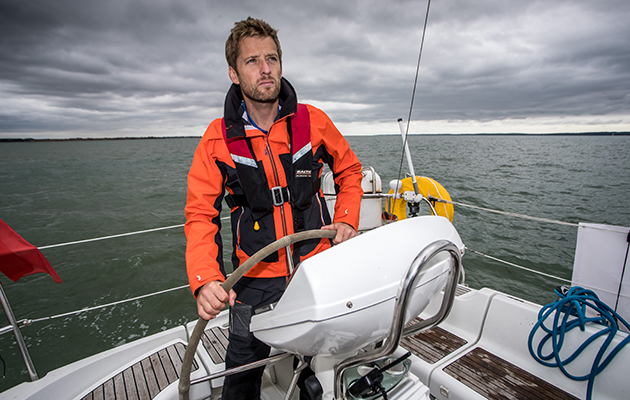Yachting Monthly experts and seasoned skippers share their advice on a whole range of issues for the cruising sailor. Do you have a tip to share? Email us at yachtingmonthly@futurenet.com
A lighter companionway

The Willis lightweight companionway door. Credit: John Willis
Pippin is a Francis 34 Pilothouse and I‘ve been her custodian since 2017.
Since that time we have covered over 4,000 miles, including a four-day solo Biscay crossing from Penzance to Ribadeo in Northern Spain, a six day return from Vigo and a Jester Challenge to Baltimore.

A Jester Baltimore Challenge veteran, John Willis has thousands of cruising miles under his belt. Credit: John Willis
On every trip I have fitted the ‘Willis lightweight companionway door’ before I set off, which is nothing more than a scrap sheet of 6mm polycarbonate roofing material, cut to fit the companionway entrance.
It replaces three heavy wooden washboards, which have no proper home, other than buried in a locker.
I can even scramble in and out without removing it, by sliding it up just far enough.
I have fallen against it, tripped over it, bent it nearly in half and still it comes back for more.
It has been in all sorts of conditions up to gale force, when I use a short cord attached though a hole in its bottom to secure it in place and to stop it blowing away when I remove it in windy conditions.
Being transparent it lets in lots of light whilst still providing privacy, and I can also use it to scribble notes on with my chinograph pencil (such as names and telephone numbers).
It cost less than a decent large glass of hair restorer and took about five minutes to measure up and cut with a portable jigsaw.
Future enhancements? I toyed with the idea of using 8mm sheet, but I can’t even destroy the 6mm stuff, so I see little point. Frankly I would not be without it now.
John Willis
Satellite navigation

Satellite images can be useful for reef spotting when charts are not accurate
During my circumnavigation I found satellite imagery to be a hugely valuable way of not only verifying my electronic and paper charts but also as the principal method of navigating through poorly chartered areas.

Thom D’Arcy has completed a global circumnavigation in his Nicholson 32. Credit: Thom D’Arcy
In Fiji, for example, where electronic charts were very inaccurate in some areas, satellite imagery allowed me to plot courses through the coral reefs with confidence.
There are various ways of utilising satellite images for navigation but I found the best to be through OvitalMap.
This is a cross-platform app for phone or tablet that allows Google and/or Bing imagery in any area of interest to be saved for offline use.
The boat’s position, speed, course and track can be displayed in real time or waypoints can be extracted in advance for plotting on your chart.
Other benefits of satellite imagery include the ability to identify that nice area of sand to drop the anchor or for studying a harbour or marina layout before arrival.
Just remember to download the data in advance when you still have an internet connection! OvitalMap can be downloaded from the Apple or Android stores.
Thom D’Arcy
Rope sleeve

This handy rope keeps rust stains at bay. Credit: Ken Endean
Rough or rusty mooring chains are a menace to smart topsides, particularly in wind-against-tide conditions when a yacht may drift forwards over the mooring, with the chain stretching aft from the bow fairlead and scraping against the hull.

Ken Endean is an inshore pilotage enthusiast who has made a close study of coastal sea conditions around the British Isles
The conventional answer is a sleeve of large-diameter hose pipe or similar material, but on a typical yacht that is unlikely to be part of the spares kit.
Also it would be necessary to unshackle the chain loop at the top of the mooring rode, in order to feed the chain through the sleeve, but many mooring providers absolutely prohibit users from doing that.
However, the same result can be achieved with a short length of old rope, and without unshackling anything.
When moored up, identify the lowest chain link that is likely to scrape against the hull.
Pass one end of the rope through that link and tie a stopper knot in the end.
Then wind the rope around the chain in a spiral, threading it through at about every eighth link, until close to the stem head, and finish off with another stopper knot.
Your gel coat or paintwork will be very grateful.
Ken Endean
Black airing bag

A good as any airing cupboard. Credit: Mary Endean

Mary Endean grew up with canal boats and for the last 50 years has been cruising under sail. Credit: Mary Endean
When we are on an extended cruise, we like to stretch the periods between visits to launderettes.
Small items of clothing are washed in a bucket and pegged out on the lifelines but drying conditions at sea may be less than ideal.
We often resort to an additional item of equipment.
When clothes are fairly dry, they are packed into a black cloth bag.
This can be positioned in any patch of sunshine, to soak up the warmth, and is as good as an airing cupboard.
Unlike a tumble dryer, it does not consume electricity or coins, so is green and mean.
Just beware of calling cards from fowl/foul visitors – seagulls.
Mary Endean




